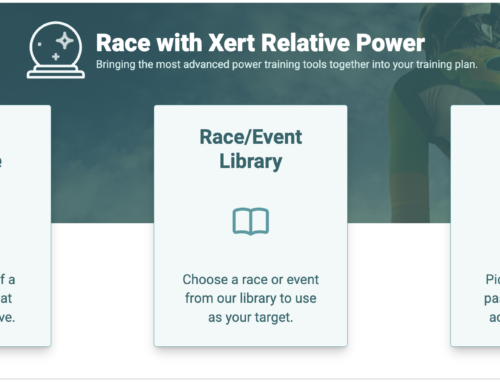Will your Training Program help you get stronger? Will it be too hard? Will it take up too much time?
So many things go into training program and many athletes aren’t sure what questions they should ask when choosing a plan. Often they just pick something to do, not knowing whether it’ll be good or bad for them. Maybe the program title sounds like something they want: “FTP Builder” or “Mid-High Volume with a Little Bit of Sweetspot Program”. But is this the right program for you?
To help you understand what’s important and why, we’re going to highlight the 10 most important questions to get answered when choosing any endurance training program. We’ll give you an idea of what answers you will get with a typical training plan, what a coach might provide and what Xert does to address them.
| Question | Typical Training Plan | Coach | Xert |
|---|---|---|---|
| What is the training plan going to be based on?
How fit am I at the moment? |
FTP. You’ll need to do an FTP test. Everything is based on this number. | FTP but also other important fitness measures, often a combination of power, heart-rate and/or lactate is used. A coach will typically ask you to do an FTP test plus other tests to get a better picture of your fitness. For example, a coach might collect your 1 minute maximum power and your 5 minute maximum power to get a better overall picture of what power you can produce. Coaches can also look historically to glean this information from your data. Coaches will get a sense of your strengths and weaknesses from this information. | Xert looks at your historical data to create an overall picture of your power capability and fatigue profile using a fitness signature. Your fitness signature is tracked with all your training history. No formal testing is involved. The system uses fitness breakthroughs discovered in your data. |
| What’s the purpose of the training?
Do I need a program that just helps me improve or do I need to prepare for something? |
This is usually something that is described in the name and/or description of the training, e.g. “FTP Builder” or some systems allow you to choose a type of event or specialty you’d like to focus on. | Coaches need to know what you’re looking for from them. Likely one of their very first questions will be: “Why are you training and what are you looking to achieve, by when?”. | Xert’s new Race AI and other Training Program options allow athletes great flexibility in defining why they are training and what they would like to achieve. With Race AI, athletes can even go so far as to train towards having the fitness to be able to perform the same as a ride that was done in the past. This may be a race/ride that they may have done themselves or a ride that another rider altogether had performed in a race, for example. Helping you determine the outcome you wish to achieve is as important as the training itself. This is where Xert’s Race AI and the other training program options provide significant value to athletes. |
| How much training does it involve?
Am I new to training or an elite cyclist looking to get to a new level? |
This is usually left up to you to choose. Often it’s a matter of choosing how much volume you can handle. You generally need a good understanding of where you are at the moment and what the plan you’re choosing offers. It’s often a very difficult decision to make and will determine our overall success in your training. | Coaches will ask you a lot of questions on the type of rides you typically do, how much you’ve done in the past and will likely confirm all this information by reviewing your data that you will be asked to supply. They can then look at changing and/or adding to what you currently do if they feel it will align with the goals you’d like to achieve with your training. How well they do this is an essential piece that affects the outcome of the program. | Xert uses a sophisticated 3 dimensional fitness and performance model to analyze your entire training and riding history to examine how you’ve trained, how it has affected your fitness and performance and how you specifically will need to train to improve. Based on this and what you’d like to achieve by when, Xert provides a very specific answer on how much training you will need to do and whether you can achieve the outcome you are looking for by the date you specify. If that’s too much training for you, you can change the outcome or the target date you are aiming for. You’re in control of the amount of training and what you can achieve. |
| How difficult are the workouts?
Am I the type that can handle hard, challenging workouts or can I only take so much suffering? |
Most programs do not offer any advanced information on how challenging the training will be. Some platforms do enable feedback on the workouts you do that then affect future workouts in an adaptive way. | Coaches will ask you to input your comments on workouts and rides that you do. This helps them assess if the training that they are giving you, are workouts you can complete and if not, they can adjust accordingly. Some do interim FTP and other testing to adjust the levels in the workout to accommodate your changing abilities. | Xert allows the athlete to modify the difficulty of the workouts that you will be expected to perform during the program. In general, the more difficult the workouts, the shorter they can be. This isn’t true for Zone 2 training but is often true with high intensity interval training. With shorter workouts, it can be easier to fit them into a busier schedule. Xert accommodates and creates the plan based on your choice of this setting. |
| How much recovery is built into the plan?
Do I need a bit more time after a longer/harder workout than the average person? Do I need less? |
As of today, how much recovery you might specifically need isn’t factored into training programs available. The recovery is built into the structure of the program in a generic way with the rest days between workouts and recovery weeks included as part of the plan. These apply to everyone. | Similar to difficulty of workouts, coaches will ask for your feedback on how you felt *before* the workout to see how their training is affecting you and generally how you cope with the volume and frequency of the training they’ve provided. How you felt on the day of the workout, sometimes reinforced with data such as resting HR or readiness data from wearables, is what coaches can use to slow down or speed up the program, adding or removing recovery days as needed. | Xert allows the athlete to adjust the amount of recovery they will get. Whether you might need less recovery because you are a professional cyclist or need more recovery because you are out of shape and new to cycling, Xert enables you to control the amount of recovery between training sessions the system should include in the training program. This can be changed at any time and a new plan generated. |
| What type of workouts are in the program?
Should I do Zone 2, Sweetspot, VO2max or in what combination? |
This is usually a more advanced concept that you’ll need to research. Some programs have descriptions using words like “Sweet Spot”, “Polarized” or “Pyramidal”. | Coaches will often ascribe to a certain training philosophy and these are often aligned with pre-established best practices as put forth by a particular sports scientist or coach’s method that they follow. For example, some coaches ascribe to Polarized Training following an 80:20 rule whereas another might do more Sweetspot. Each will follow different rules and methods that have worked for them with other athletes in the past. | Xert doesn’t ascribe to any specific training philosophy in the training programs that you receive. For themore advanced users, there are settings you can modify such as Polarization and Periodization Level if you prefer to have more direct influence on how the training plan will be laid out. This flexibility provides athletes greater control on the “philosophy” it should employ in devising a training program. |
| What’s the weekly training schedule?
I need a plan that’s only 10 hours a week and on specific days and times. |
Most programs come with a preset schedule that you’ll need to follow and incorporate into your weekly routine. Some will ask you for your time availability and schedule the training within these time slots. | Some coaches are flexible and will accommodate those with tighter schedules whereas others are stricter in terms of the schedule they demand that you keep. | Xert allows you to be very specific on the days you are available to train and for how long. This can be by day-of-the-week or specific days during the program. You can modify your availability at any time and request the system to readjust your program and accommodate that scheduling requirement. |
| Can the plan accommodate other scheduled rides?
I have club rides on weekends and like my Wednesday-scheduled virtual ride indoors. |
The majority of training programs do not incorporate any other rides into the plan they provide. You are expected to follow the plan and do the workouts specified in the way they are planned out for you. Some may include days with unstructured outdoor riding but this isn’t common. | Some coaches demand that you do the workouts they prescribe and do them the way the way they prescribe them. Some are more flexible and can accommodate other rides, for example, as part of their training. Some that use Xert, are moving towards more unstructured completion of workouts using Xert’s XSS Buckets. | Xert’s Forecast AI takes this idea further than any other platform. Not only can you request that the system accommodate preset rides you already do and include them in your plan, you can also decide to do the training in a variety of ways that better suit you. You are not restricted to doing workouts. You can decide how you’d like to complete the training. For example, an online race may fit your training needs well and you can opt for that instead of a workout for your training. Xert helps you assess these other options and whether they can be used to fulfill the training needed in your program. |
| Is the plan adaptive and does it change over time based on how I’m doing?
My schedule is crazy. Family. Work. Weather. So many things getting in the way. |
Most programs are very rigid and do not adapt based on your changing needs or schedule. Newer systems are becoming more adaptive by taking feedback about your progress and making adjustments as you require them. | Coaches will move things around to accommodate schedules as well as your changing fitness and success in following their program. Often the coaches that are more flexible generally cost more since they will need to spend more time on you than other athletes that don’t require a lot of changes. | Xert’s training programs are adaptive as you perform them. Everything is included when a training program is generated, including what training you did successfully or were not able to complete. Are the workouts too hard? You can adjust the difficulty and adapt the program to accommodate. Need more recovery? Adjust the recovery demands and adapt the program. Have more time to train? Adjust availability and adapt the program. The plan is adapted to your needs and changes as you need it. |





